The End Of The Hodiamont Streetcar Right-of-Way
Forty-six years ago today the last streetcar in St. Louis stopped rolling down the streets. The Hodiamont was St. Louis’ last streetcar line. The Hodiamont ran in city streets from downtown to just west of Vandeventer Ave where it went into its own private right-of-way.
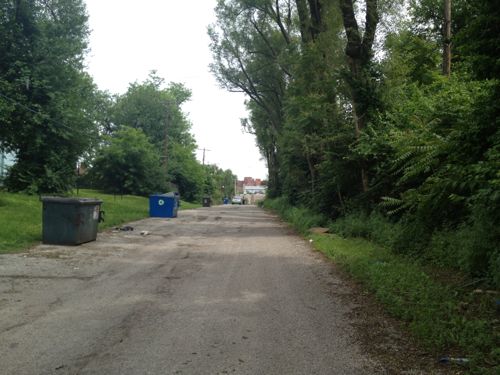
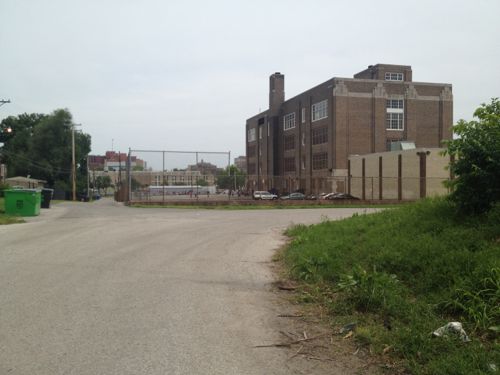
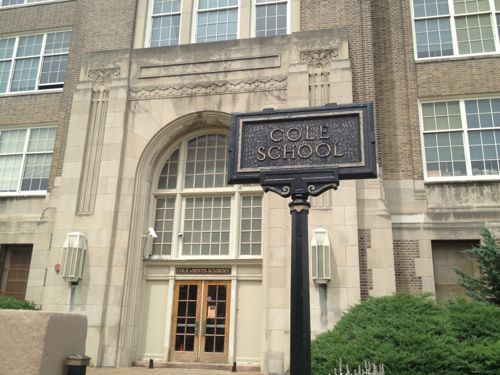
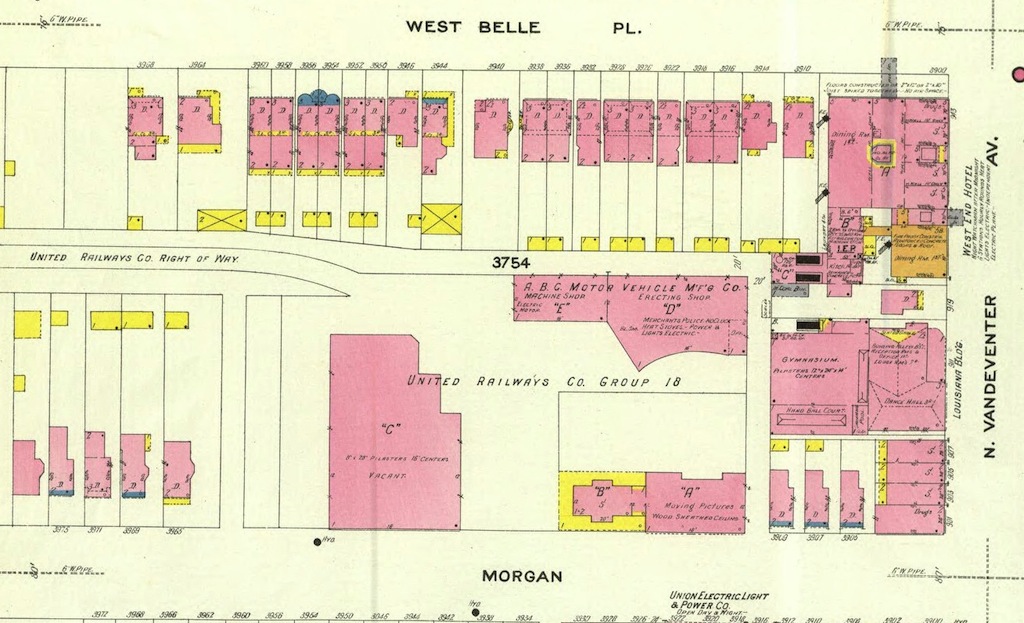
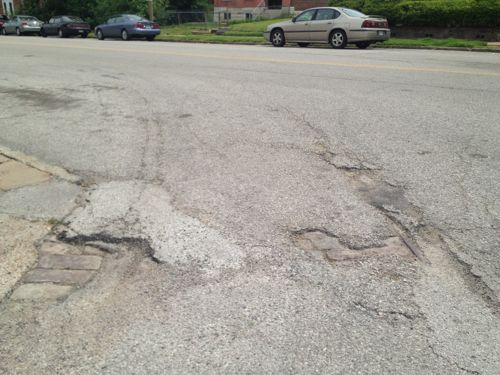
ABOVE: The streetcar tracks come out of the private right-of-way and head east on Enright Ave
Eventually new rubber-tire buses with air-conditioning replaced the older streetcars:
Only three lines were left in April 1964, when the new Bi-State agency winnowed the system to the Hodiamont line, which ran from downtown to the Wellston Loop. Along the way through north St. Louis, the Hodiamont had its own right-of-way, like a railroad. (STLtoday.com article from 2010 — recommended)
I can’t help but wonder if running a new modern streetcar through this right of way today would make sense. Or even a bus line?
— Steve Patterson
I’d love to see street cars again for many reasons. And thanks so much again :o) for reminding me how old I’m getting!
This old rail line is fascinating to me. Miraculously, a handful of the old street signs from the streetcar days still survive along the line:
http://stl-style.com/_blog/STL-Style_Blog/post/Remnants_from_the_rails/
Excellent pics Jeff, thanks.
It’s always interesting to see the nostalgic focus on historic infrastructure when the real issue is moving people between point A and point B. IF the vehicles and the right-of-way still met people’s needs, it would still be in use. The Chicago El and the NYC subway system are just as old, if not older, and continue in use today. People chose to switch to, and still choose, buses and private vehicles not because they dislike or hate streetcars, they simply choose what works best to make their trips as easy, quick and direct as possible.
There’s also an old interurban right-of-way that can be traced from University City all the way out to Creve Couer Lake, as well as parts of the streetcar right-of-way from Clayton to Kirkwood. Would it be possible to reclaim and reuse parts or all of these ROW’s? Sure, anything is “possible”. But the reality is that the world has changed, significantly, over the past 100-120 years. Kirkwood and Creve Couer were the farthest reaches of the metro area back then, Cottleville and Dardenne Prairie are now. We travel greater distances because we can and because we have destinations we want to reach in the suburbs. We have freeways and Metrolink. We’d rather drive than take public transit. Streetcars may have a place in the mix, but only as a transportation solution, not just as an historic allusion . . . .
It’s always interesting to see you assume something stopped working because it didn’t meet the needs of the end user. The end of streetcars in north america is a very complicated subject. Toronto, New Orleans and San Francisco kept streetcars and they continue to meet needs. Cities, including St. Louis, are spending massive sums to replace streetcars because an unmet need exists.
Hey, I agree, it’s complicated. But, cue the rant, the reality is that we have, for the most part, moved beyond streetcars, here, in St. Louis. I get it, you like streetcars and you think that their return would make the city more urban and more urbane. You think that their return would spur reinvestment in the same way that they have in Portland and Toronto. I only wish that that were the case, that it were that simple. Until we “fix” the (mis?)perceptions about crime, schools, race and corruption in our fair city, it won’t matter (much? at all?) if we run buses, streetcars or limousines down streets like Page or Natural Bridge or the abandoned Hodiamont right-of-way. Until we contain sprawl, we’re going to see continued (unsustainable?) growth on the fringes. Until we do more with our large, vacant, industrial parcels than just clear them them and put up a “For Sale or Lease” sign, we’re going to continue to look like a failing rust-belt city. It’s that old, “You can put lipstick on a pig” – demand, not random public amenities, drives investment, especially on the private side. We need a lot more people who want to both live and work here, and not “flee” to the “safety” of the suburbs!
I appreciate the historic significance of these corridors, but to expect them to somehow come back, now that the rest of the world has evolved (and not necessarily for the better) over the past fifty years, is, at best, an academic exercise. The Wellston Loop is beyond dead when it comes to commercial, so why would you expect a streetcar to do any better than the current bus?! If you had talked to the longtime residents of the area, my guess is that just as many, if not more, were glad to see the streetcars go, to get them out of their backyards, as you would find lamenting their demise. And, are you saying that a public school is not a good use for the site? The Delmar Loop is great, but it’s both an aberation and depends heavily on its location, Joe Edwards and Wash U and its students for its success (and not on public transit), while our other old trolley loops have all faded into obscurity.
In Pittsburgh, they had similar dedicated rights-of-way, only they converted many of them to dedicated busways. In Denver, they’ve created both busways and light rail lines out of a variety of corridors (surface street, rail and freeway). I wasn’t here when Bi-State took over, I wasn’t even here ten years ago. I don’t know why our leaders here chose buses over streetcars, freeways over mass transit, but that’s our current reality. I’d love to be able to invest billions of dollars in a rail-based transit system that would actually do a good job serving not just the city, but the entire region, but it ain’t gonna happen, not in this political and economic environment. I’m also getting old enough to not to want to fight battles I can’t win. Given our generous street widths, in many parts of the city (yes, a legacy of our streetcars), and our finite resources, I’d much rather see more investment in buses, more bang for the buck, and to see us create one of the better bus systems in the country. It’s working in LA, it works in Chicago and Boulder. More frequency, a better fare structure, better marketing and a change in perceptions are all needed, but we’re spending way too much time and effort on things like the Loop Trolley and arguing about where the “next” Metrolink line should go, instead of figuring out how to build 4, 5 or 6 at the same time (like Denver is doing).
Until we all accept that both our city and our region are way less dense than it was a century ago, we’re going to fail at delivering mass transit that works for today’s needs. We need to give most people a reason to get out of their cars, every day. It doesn’t matter if they’re rich or poor. A streetcar is a bus with steel wheels. It functions no differently than a local bus. And if it comes down to spending a buck on gas or two bucks to take transit to go a mile or two, AND it’s going to take way longer to use transit (because the bus or new Loop streetcar only runs every 20 or 30 minutes) AND parking is “free” at both ends, give me a good reason why I would choose transit on a daily basis (not just out of couriosity)! We can’t sustain any transit system just on the occassional rider, we need daily commuters. If people won’t ride the bus or Metrolink to work now, why would you expect them to embrace a streetcar? We don’t live in the compact, dense city that was St. Louis in 1912, we live in the heart of a sprawling metropolitan area that’s, what, 10 times as big with the SAME NUMBER OF PEOPLE! What worked then, won’t work now!
We need park-and-rides with frequent service on the residential end and we need dense workplaces. We need frequent, free circulator buses in both downtown St. Louis and downtown Clayton. We need to meet the transportation needs of both the users and the employees at all our hospitals and universities in the same way we do at BJC, Wash U and UMSL. SLU, Webster and Lindenwood all have significant populations, as do Mercy, St Anthony and Missouri Baptist. Wells Fargo, Ameren, Purina and A-B could all embrace transit if it did a better job of serving their employees. You’re right, it’s complicated, but my main point is that streetcars are just a tool. If people won’t ride transit, especially for commuting, it’s rarely because of the specific vehicle, it’s all about the percieved price, and, most importantly, the time it takes – if time can be saved, then transit becomes a whole lot more attractive (and that’s rarely the case in St. Louis)!
Metro doesn’t like to run rail in mixed traffic, they prefer a dedicated right-of-way. But MetroLink being an old heavy rail line isn’t close to the A & B points that need connecting. I’m fine with a bus line using the Hodiamont ROW.
The streetcar lines were shut down in St. Louis and across the nation by a consortium of Standard Oil, Firestone and GM which formed a company National City Lines. It is the same corruption we see today. Effective mass transit was maintained in many other cities where it continued to be successful. Nor should you discount the urban policies which wiped out whole communities such as Mill Creek Valley. Sprawl and the decline of the streetcar is not an accident based on individuals choosing autos, People were forced into autos and even today, if you haven’t noticed, it is the policy in the St Louis region.
“Effective mass transit was maintained in many other cities where it continued to be successful.” I agree, that’s exactly what I said. Here, the streetcars were not successful. They were obviously old and wearing out, ridership was undoubtedly down. There were competeing companies, which I assume meant limited transfers. The choice was made to convert to buses. Whether it was a conspiracy or just evolutionary improvements in bus technology, buses were chosen for financial reasons, they were less expensive to operate yet were still able to deliver the same level of service.
“People were forced into autos” – no one held a gun to my head or my parents’ or my grandparents’ heads! “and even today, if you haven’t noticed, it is the policy in the St Louis region.” That you must own a car? I don’t think so. We get the built environment that most of us want, that we support, by electing politicians who will build, maintain and rebuild our streets, roads and freeways, and by shopping in stores with convenient, free parking and offering drive-thru windows (so we don’t even need to get our fat butts out of our cars).
Streetcars are like landline phones. They’re great at what they do, but times and technology change. There are significant advantages to goiing wireless, to not being constrained to a limited number of fixed points. If you’re good with that rotary wall phone in the kitchen, go for it, I really don’t care. Personally, I prefer the freedom to have a phone in my pocket and a personal vehicle outside my front door.
I’m not from the gun to the head branch of urban planning, so I can’t speak to your assertion that your parents and grandparents weren’t forced to use automobiles. As I point out in a previous comment about Stockholm, their suburbs were built to give people transit choices. (True of many cities around the world) Like it or not the government in St. Louis does what the corporate masters demand, whether or not it is in the interests of the citizens.
Streetcars in St. Louis were successful, and as I said before, corporate interests shut them down, because selling more oil, autos, tires and so on, was their agenda, not successful electric streetcars.
You live in some imaginary world so that you think markets are defining what is built. The truth is far different. It is not the markets, but poor government policies influenced by the needs of corporate insiders. It is not a free market determining outcomes.
In the simplest terms there are two design approaches, one that offers transit options, the other is a design approach that forces people to use the auto.
The St Louis region forces people to use the auto with few transit alternatives. I would think as an architect you would understand the differences in design, but maybe not.
Where do “poor government policies” originate? From the elected officials “we, the people” choose to elect. I’ve lived in Boulder, Denver, Louisville and here (among other places) and each city has a distinct way of addressing urban design, public transit, growth, sprawl and economic development issues. The outside influences, “the corporate masters”, “the consortium that formed National City Lines” were and are pretty consistent across the country, it’s how the local officials evaluate, react to and embrace their influences that truly determines the final outcomes. It’s called leadership (or a lack thereof).
The predominant streetcar model from the 1930’s, 1940’s and 1950’s is the PCC (President’s Conference Committee) model, produced here in St. Louis (http://en.wikipedia.org/wiki/PCC_streetcar and http://en.wikipedia.org/wiki/St._Louis_Car_Company). Given the company’s importance to our local economy, why would our leaders be so short-sighted as to sabotoge its on-going success? Or do you live in a fantasy land where centralized government is always the best and only good answer? I agree, “The St Louis region forces people to use the auto with few transit alternatives.” Where we’ll probably never agree is why this has come to be. I see no great conspiracy, I just see a loit of people voting with their feet.
Dont you think that the fact that people went from walking, to horses to mass transportation (since only the rich could afford those new things called cars) then to cars (when everyone could afford one) had something to do with the demise of the lines as well?
And now we have 2 generations where it has been get in and go, not walk to the bus and go. Times are changing.
We still have public transit. Also more and more young people are opting for transit over cars.
Define “more and more”. 3% is now 5%?
I think it’s more that young people are moving to places where people don’t need cars (like NYC and Chicago) than that they are staying in St Louis and no longer using cars.
Many young people have been attracted to the “big city”, and have been, for years. While I tend to agree that people who want to rely on public transit will gravitate to areas that offer good/better options, and that St. Louis is not positioned well to compete for these, it’s going to take stats, not just a gut feeling, to justify Steve’s original assertion.
Much like the discussion on transit, this is a complex discussion, as well. The biggest priority for most young people is a job, either a “good” one or just one with a paycheck; getting there is secondary. And with many jobs now being located in areas poorly served, if at all, by public transit
Here you go: “The average annual number of vehicle miles traveled by young people (16 to 34-year-olds) in the U.S. decreased by 23 percent between 2001 and 2009, falling from 10,300 miles per capita to just 7,900 miles per capita in 2009.
The share of 14 to 34-year-olds without a driver’s license increased by 5 percentage points, rising from 21 percent in 2000 to 26 percent in 2010, according to the Federal Highway Administration.”
http://www.theatlanticcities.com/commute/2012/04/why-young-americans-are-driving-so-much-less-their-parents/1712/
Thanks for the specifics. As with all statistics, they can be spun many ways. The most telling one is in “Figure 1, VMT per capita peaked in 2004”. It shows the peak at slightly more than 10,000, dropping to the current number of approximately 9,500. What the narrative conveniently ignores is that over my driving life (got my license in 1969) VMT’s per capita have nearly DOUBLED – 9,500 is still way more than 5,500!
And to quote: “Part of the reason for this shift is financial. The report calculates
the average cost of owning and operating a car as north of $8,700
dollars a year, and that was before gasoline passed $4.00 per gallon. In
the wake of the financial crisis, many underemployed young people have
decided that they either can’t afford a car or would rather spend their
money on other things. The report cites a Zipcar/KRC Research survey,
which found that 80 percent of 18 to 34-year-olds stated that the high
cost of gasoline, parking, and maintenance made owning a car difficult.” Add in the ballooning college debt load many college graduates are leaving school with, and it’s no surprise that poverty is forcing some hard choices, including living at home and using one’s parents’ cars . . . .
There was a time when young people always put owning a car at the top of the list and did without other things in order to keep the car in the driveway. So, since owning a car is now financially difficult, the statistics still make the point that priorities have changed for young people, so that the car has moved down the list.
And I would like to know are leases included in that “owning”….today it is far easier and cheaper to lease a car than it is to buy one.
“In 1983, 69% of all 17-year-olds had driver’s licenses. By 2008, only half of 17-year-olds had licenses.” http://moneyland.time.com/2011/12/08/fewer-teenagers-have-drivers-licenses-because-of-gas-prices-and-the-internet/#ixzz1vXw5IqQv
Laws have changed, and the ease of getting a license at various ages is different from what it used to be.
I refer you to a book on the building of suburbs of Vallinby and Farsta outside Stockholm in the sixties. (David Pass, Mit press) Rail was integrated into the new suburbs, so much so that today I believe something like 80 percent of commuters use transit instead of autos. In any case it illustrates clearly the difference between a transit friendly environment and one that forces people into cars as we have today in the St. Louis region. Policies, including shutting down streetcar lines, contributed to the autocentric life in sprawl city USA.
The people of Stockholm have transit choices through good design, most people in St. Louis have no choice but to use the automobile. That is by design also, but it is corporate design for higher profits, not design to serve the peoples interests.
And when Harland Bartholomew left St. Louis in 1950 he went to Washington D.C. and helped plan their rail system that serves suburbs in two states.
How would mass public transportation pay for the loss of income from owning an automobile ?
Such as,traffic tickets red light cameras,parking tickets,parking fees, license fees,sales tax.,personal property tax,vehicle upkeep,manufacturing jobs in auto industry .
The federal gasoline tax [ avg 37c a gal] that pay the subsidies for highways and public mass transit . .. federal highway gasoline tax fund 59 percent for highways and 21 percent for mass public transit.
Where would the state and cities replace the income in their budgets come from if these taxes and fees would suddenly disappeared?
just where does the state’s tax on gasoline go and all the other fees and taxes on owning an automobile go?
..
Federal and states tax on gasoline is about equal ,averaging about 49 cents a gallon .Federal fuel tax is 18 gas, 24 diesel
In some states, the STATES gasoline tax can run as high as 51 cents.
Here is my basic understanding of streetcar decline, in the 30s a law was passed making it illegal for power companies to own streetcars, which further tightened margins. This law, I have read, has largely been repealed. Also, streetcarcompanies had to pay for street maintenance unlike bus companies. I’m sure suburban sprawl was also a factor. I’d love to see streetcars make a comeback, but I want to see private money find a way to do it. Perhaps if you let them Joint venture with ameren, and own and rehab LRA properties on north grand, we might get a model for a Grand streetcar. I picked Grand because I hear it is the busiest bus route.
If you’ve got a sweet, uncontaminated corridor like that, use rail. Buses are easy like sunday morning, but a historic rail corridor with minimal utility impacts is a gem.